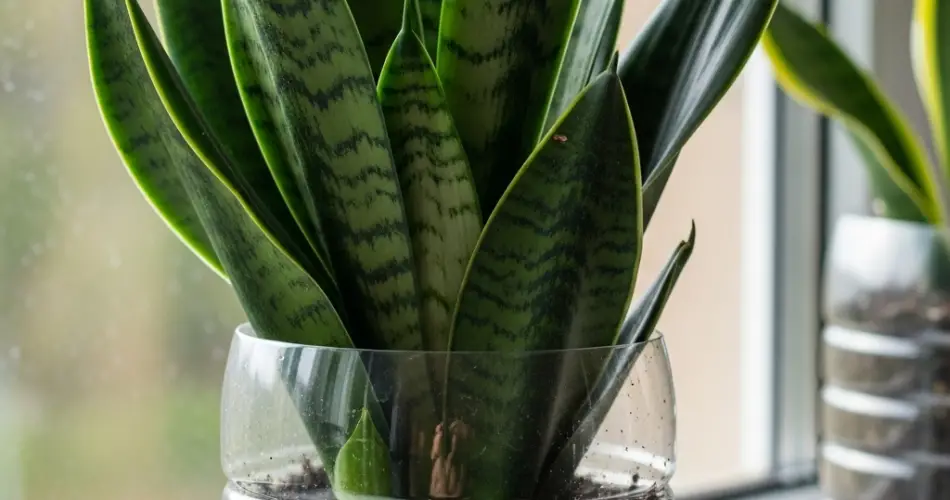Snake plant (Sansevieria), also known as mother-in-law’s tongue, is one of the easiest and most resilient houseplants to grow. Its upright sword-like leaves, often banded in shades of green and yellow, make it a striking addition to any space. Best of all, it requires minimal care, thrives in a range of lighting conditions, and even helps purify indoor air.
For those looking to combine sustainable living with indoor gardening, growing snake plants in upcycled plastic bottles is a smart and creative option. This method not only saves money but also reduces plastic waste, turning trash into beautiful plant displays.
Why Snake Plants Are Ideal for Bottle Growing
Snake plants are known for their toughness. They tolerate drought, neglect, and a variety of indoor environments. Because they grow slowly and don’t need frequent repotting, they adapt well to small or unusual containers—like plastic bottles.
Benefits of using plastic bottles for snake plants:
-
Affordable and eco-friendly
-
Lightweight and portable
-
Perfect for small spaces or windowsills
-
Easy to decorate and personalize
-
Encourages creative recycling
Whether you’re a beginner or an experienced plant lover, growing a snake plant in an upcycled bottle can be both fun and functional.
What You’ll Need
To get started, gather the following materials:
-
A clean, empty plastic bottle (1.5–2-liter size recommended)
-
A sharp cutter or scissors
-
Pebbles or small stones for drainage
-
High-quality cactus or succulent potting mix
-
A healthy snake plant (or a cutting)
-
Optional: paint, string, or fabric to decorate the bottle
Preparing the Plastic Bottle Planter
Step 1: Clean and Cut
Wash the bottle thoroughly to remove any labels or residue. Using scissors or a craft knife, cut the top third off the bottle. You’ll use the bottom portion as the planter.
Optional Self-Watering Version:
If you’d like to create a self-watering pot, invert the top part of the bottle into the bottom section (like a funnel) and thread a cotton rope through the bottle cap. This wick will draw water from the reservoir below into the soil.
Step 2: Add Drainage Layer
Place small stones or pebbles at the bottom of the bottle to improve drainage and prevent water from pooling at the roots.
Potting Your Snake Plant
Snake plants prefer well-draining soil. Use a succulent or cactus mix, or make your own by combining:
-
2 parts potting soil
-
1 part coarse sand or perlite
-
1 part coco coir or bark for aeration
Gently remove the plant from its original pot, shake off excess soil, and inspect the roots. If using a cutting, ensure it has been dried for a day or two before planting to prevent rot.
Plant the snake plant in the prepared bottle, ensuring the roots are just below the soil surface. Press the soil gently around the base to stabilize the plant.
Ideal Light and Placement
Snake plants thrive in a range of lighting conditions, from bright indirect light to low light. This makes them highly versatile for indoor spaces.
Placement tips:
-
Place near an east or west-facing window for best growth.
-
Tolerates low-light areas like hallways or offices.
-
Avoid prolonged direct sunlight, which may scorch the leaves.
Rotate the bottle occasionally so the plant grows upright and evenly.
Watering and Maintenance
One of the key benefits of snake plants is their low water requirement. Overwatering is the most common mistake.
Watering tips:
-
Water only when the soil is completely dry.
-
In warm seasons, water about every 2–3 weeks.
-
In winter, water sparingly—once a month may be enough.
-
Ensure no water pools at the bottom of the bottle.
If using a self-watering setup, monitor the water level in the reservoir and refill only when dry.
Fertilizing and Growth
Snake plants don’t need frequent feeding. During the growing season (spring and summer), apply a diluted cactus or houseplant fertilizer once every 6–8 weeks. Avoid fertilizing in fall and winter when growth slows.
Snake plants grow slowly and may only need repotting every few years. If the bottle becomes too tight or the roots circle the container, transfer the plant to a larger container.
Styling and Display Ideas
Make your upcycled bottle planter a decorative feature by personalizing it:
-
Paint the outside of the bottle with acrylics or wrap it in twine or jute.
-
Use multiple bottles to create a row of plants on a windowsill.
-
Hang them using macramé or wire hangers for vertical greenery.
-
Mix snake plants with other upcycled planters for a cohesive eco-themed display.
The upright form and architectural look of snake plants pair well with minimalist, modern, or rustic interiors.
Conclusion
Growing a snake plant in an upcycled plastic bottle is a rewarding way to blend sustainable living with indoor gardening. These tough, adaptable plants are perfect for beginners, busy homeowners, or anyone looking to add a touch of nature without the hassle. With minimal care and a little creativity, your plastic bottle can transform into a stylish, eco-friendly planter that houses one of the most dependable houseplants around. Let your green thumb flourish—sustainably.



